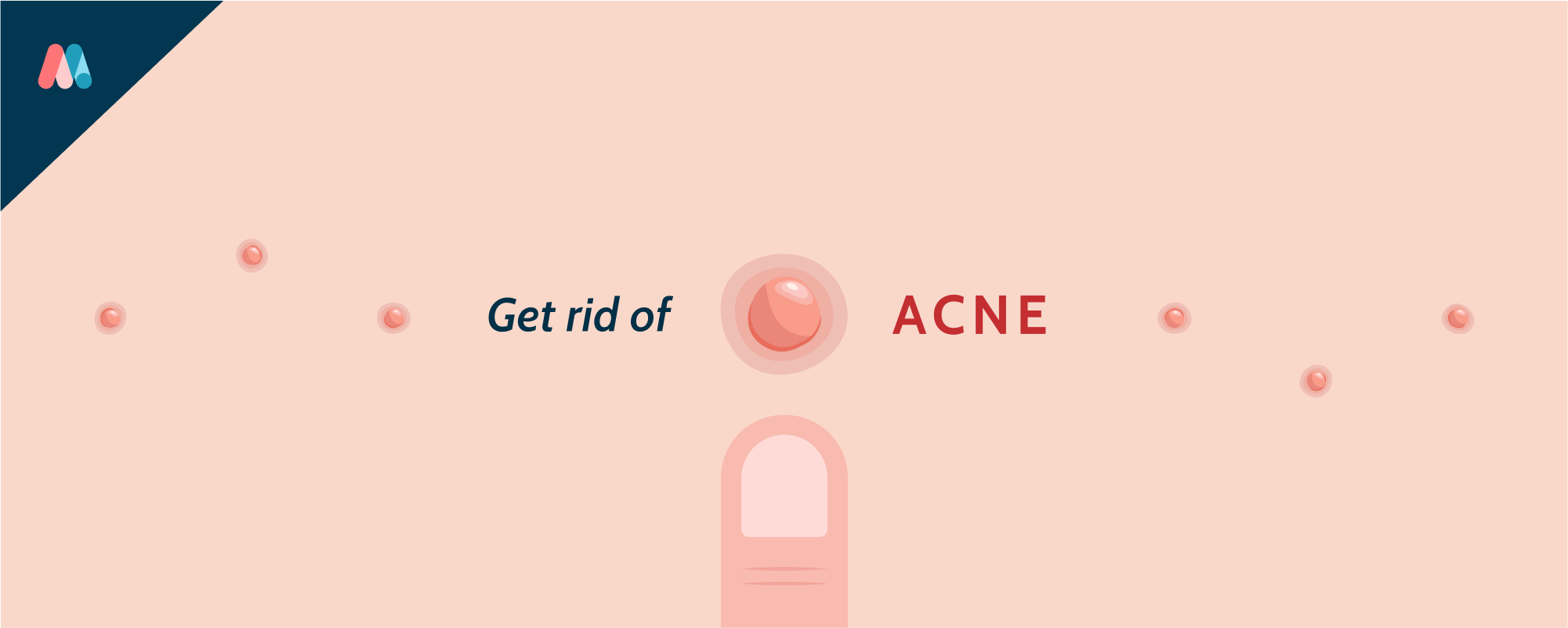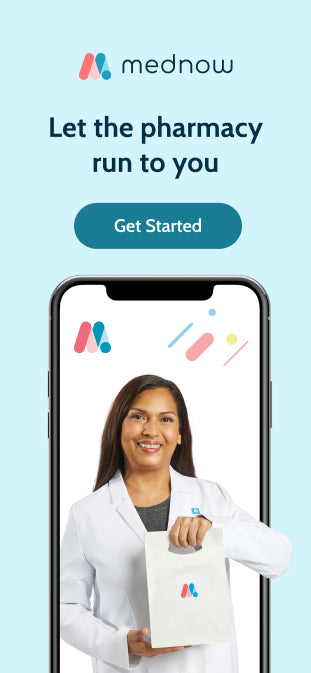Whether you call them zits, pimples or spots, acne is an unfortunate fact of life for many of us. While the hormone changes of puberty can certainly trigger acne, teens and pre-teens are far from the only ones impacted.
In this article, we’ll offer some insight into what acne is, talk through some ways to minimize breakouts and we’ll cover when it’s time to seek medical advice.
How to get rid of acne - the short version
- Wash with a gentle cleanser... but not too often!
- Resist the temptation to pimple pop
- Avoid food triggers
- Speak to a pharmacist for advice (Mednow can help)
- Look for natural remedies
- For severe acne, seek a doctor’s advice
What Is Acne?
Acne is an inflammatory skin condition.
Acne occurs when pores or hair follicles get clogged with oil (also known as sebum) and dead skin cells. These clogs lead to eruptions or lesions — commonly called pimples, zits or spots — on the face, chest, back, and shoulders.
Acne affects approximately 20 percent of Canada’s population. However, everyone’s experience with acne is different. This condition affects some people more severely than others, and it can also impact them at various stages of their lives.
Types of pimples
There are several types of pimples that people with acne may develop. The pimples associated with acne fall into six categories.

Blackheads
Blackheads are small pimples that may be black or yellowish in colour. When the sebum clogging the pore reaches the surface of the skin and becomes exposed to the air, it forms a blackhead.
It’s important to note that the air causes discolouration in the sebum. Blackheads are not a sign that the skin is “dirty.”
Whiteheads
Whiteheads are pimples that have a white bump on top. These occur when the sebum stays below the surface of the skin.
Papules
A papule is a small, red, inflamed bump. It typically feels tender or sore to the touch.
Pustules
Pustules are similar to papules. However, they feature a white tip or yellow tip in the centre, which is caused by a build-up of pus.
Nodules
A nodule is a large, hard lump that builds up beneath the surface of the skin. It can be quite painful and sore.
Cysts
Cysts are the most severe type of acne.
A cyst is a large, pus-filled lump that resembles a boil. Cysts are more likely to cause permanent scarring compared to other kinds of pimples.
Self care to get rid of acne
Millions of Canadians struggle with acne every day. The good news is that there are lots of ways to improve acne and get rid of pimples.
Here are some self-care strategies you can start implementing today:

-
Wash your face: Use a mild cleanser and lukewarm water to wash your face in the morning and evening. Wash consistently but not too often. No more than three times a day as a rule of thumb. Over-washing can dry out or irritate your skin and actually make breakouts worse.
- Don’t squeeze or pop pimples: Resist the urge to squeeze or pop your pimples. This introduces more dirt and oil and can cause scarring.
- Choose the right makeup and skincare: If you wear makeup, avoid heavy and oil-based products. Look for makeup products designed for acne prone skin.
- Moisturize properly: Moisturize after washing your face to prevent drying out your skin. Drying can lead to more oil production and can worsen your breakouts.
- Wash your hair: Oil from your hair can cause breakouts on your skin, so be sure to wash your hair regularly and if possible, keep it tied back. Especially during exercise.
- Avoid dietary triggers: Some people find that dairy products or high-sugar foods can worsen their acne. Avoiding these foods can help to minimize the frequency and severity of breakouts.
- Exercise regularly: Exercise has a net benefit impact on just about everything. While it might not improve your acne directly, it produces mood-boosting endorphins that can help you feel more confident as you navigate your skin woes. Be sure to wash your face and shower after exercising to get rid of sweat and oil that may cause breakouts.

Who's affected by acne?
Plenty of teenagers struggle with acne because of hormone fluctuations that lead to excess oil production. However, acne is not just a teenage thing.
People of all ages may develop pimples for several reasons, including:
- Pregnancy: Hormonal fluctuations that occur during pregnancy can increase oil production and lead to breakouts.
- Medication side-effects: Some medications like corticosteroids, lithium, and certain types of birth control list acne as a possible side-effect.
- Family history: Those who have a family history of acne may be likely to deal with it themselves.
Acne can also affect athletes who frequently wear tight clothing or helmets while sweating. Humid environments and areas with a lot of air pollution can also contribute to clogged pores and more frequent acne breakouts.
Natural Products that can help with acne
Natural products and practices might lessen the severity and duration of acne outbreaks. Here are some of the best ones to consider adding to your routine:
- Witch hazel: Witch hazel comes from the bark and leaves of the witch hazel shrub. It can fight bacteria and relieve inflammation caused by acne.
- Tea tree oil: Tea tree oil comes from the leaves of the Australian Melaleuca alternifolia tree. It fights bacteria and works similarly to acne products that contain benzoyl peroxide.
- Green tea extract: Green tea contains polyphenols, which reduce inflammation and combat bacteria. Applying green tea extract to the skin or taking green tea extract supplements may help you get rid of acne.

For mild acne, natural remedies and the self-care practices discussed earlier in this guide can help. For more severe cases, further medical intervention may be required.
Getting rid of acne: Speak to a pharmacist

For those who have severe acne or acne that isn’t getting better with natural remedies and self-care, an over-the-counter or prescription acne treatment might be necessary.
A pharmacist can recommend products and options to reduce breakouts. In some provinces, pharmacists can also prescribe certain acne medications not available over-the-counter. Be sure to share what you’re already doing (e.g. which of the natural remedies and self care interventions you’ve tried and any improvement you’ve seen).
You can speak to a Mednow pharmacist in a video or text chat using the Mednow app (Android | iOS | in a browser) or by calling 1-855-MEDNOW-1 to learn more.
Getting rid of acne: When to speak to a doctor

If you don’t have luck with over-the-counter products or the treatments a pharmacist can prescribe, you may need to schedule an appointment with a doctor. A doctor can assess your skin condition more thoroughly and if needed, might prescribe acne interventions including antibiotics or acne medications such as Isotretinoin (brand name: Accutane).
Get rid of acne today
No two people are alike and so no two cases of acne are exactly alike. These interventions may help get rid of acne but there’s no substitute for 1:1 care from a pharmacist or doctor.
Call 1-855-MEDNOW-1 or use the Mednow app (Android | iOS | in a browser) to speak to a caring Mednow pharmacist today.
This article offers general information only and is not intended as medical or other professional advice. a healthcare provider should be consulted regarding your specific situation. while the information presented is believed to be factual and current, its accuracy is not guaranteed and it should not be regarded as a complete analysis of the subjects discussed. all expressions of opinion reflect the judgement of the authors as of the date of publication and are subject to change. no endorsement of any third parties or their advice, opinions, information, products, or services is expressly given or implied by mednow or its affiliates.
Commencer
